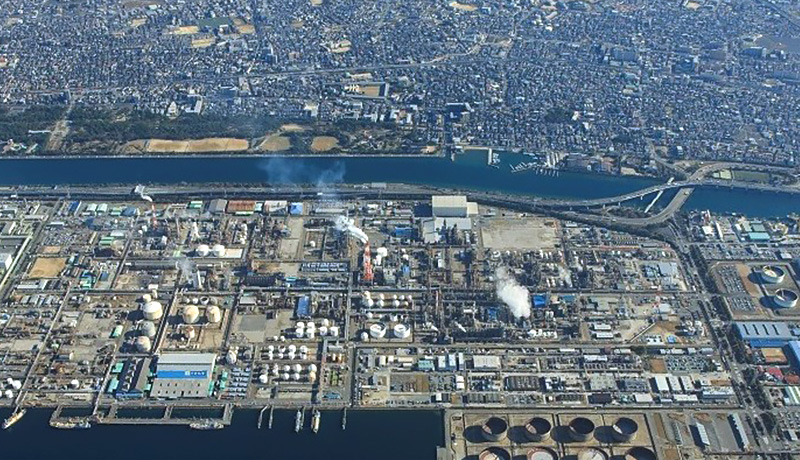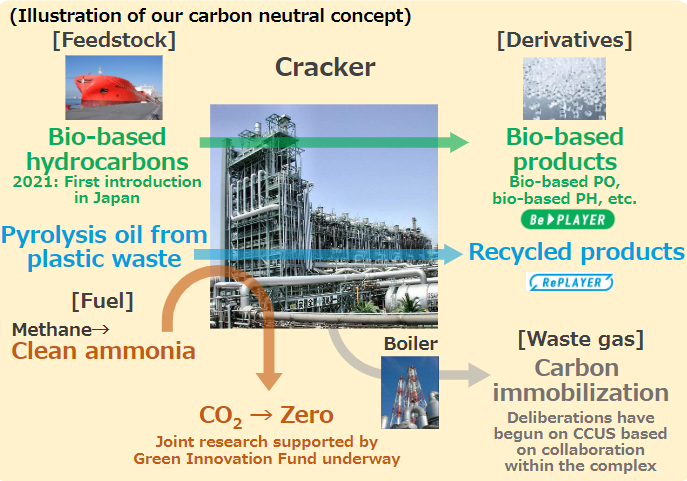Mitsui Chemicals Launches Efforts to Realize a Carbon Neutral Vision for the Osaka Works
2023.06.01
Mitsui Chemicals, Inc. (Tokyo: 4183; President & CEO: HASHIMOTO Osamu) today announced its formulation of the Carbon Neutral Vision for the Osaka Works, part of a broader effort to achieve carbon neutrality throughout the Mitsui Chemicals Group. Aims under this vision are to use the Osaka Works – one of the company’s mainstay production sites, located in Takaishi, Osaka – as a model for implementing a package of technologies that can feasibly be introduced in 2030 or thereabouts. Mitsui Chemicals intends to work on translating this vision into reality going forward.

Aerial view of the Osaka Works
The Carbon Neutral Vision for the Osaka Works
(1) Fuel transition for naphtha crackers
Methane is currently used to fuel crackers that pyrolyze naphtha at temperatures in the region of 850 degrees Celsius. Under the vision, however, Mitsui Chemicals will reduce CO2 emissions from these crackers*1 by converting them to run on clean ammonia instead. If undertaken at all crackers, this fuel transition is forecast to reduce CO2 emissions by approximately 700,000 tons.
*1 The plan to switch these crackers to run on ammonia has been adopted as an R&D project under NEDO’s Green Innovation Fund. This project has seen Mitsui Chemicals partner with Maruzen Petrochemical Co., Ltd., Toyo Engineering Corporation and Sojitz Machinery Corporation to undertake joint development aimed at implementation in 2030.
(Reference) https://jp.mitsuichemicals.com/en/release/2022/2022_0218.htm
(2) Alternative feedstocks for naphtha crackers
Transitioning away from the fossil fuel naphtha currently used to make chemical products, Mitsui Chemicals will switch to bio-based hydrocarbons*2, other biomass-derived raw materials and pyrolysis oil from plastic waste. In addition to manufacturing renewable chemicals from these feedstocks, Mitsui Chemicals will consider further canceling out its CO2 emissions by using the mass balance method to assign biomass-derived properties to 200,000 tons of CO2 emitted by the Osaka Works.*3
*2 In a Japanese first, December 2021 saw Mitsui Chemicals receive a delivery of bio-based hydrocarbons at the Osaka Works and begin production of renewable chemicals.
(Reference) https://jp.mitsuichemicals.com/en/release/2021/2021_1214.htm
*3 Mitsui Chemicals will move forward with deliberations regarding a new certification system for allocating biomass-derived raw materials to the company’s CO2 emissions.
(3) CO2 utilization and storage
- Byproduct gases and oils produced by naphtha crackers are used effectively in utility plants and the like. With the aid of capture and liquefaction devices, Mitsui Chemicals will convert 700,000 tons of CO2 emitted in this process into liquefied CO2.
- Mitsui Chemicals will consider using some of this liquefied CO2 in collaborative carbon capture and utilization (CCU) efforts at the industrial complex.
- While working to expand collaboration at the complex to a larger scale, Mitsui Chemicals will also consider carbon capture and storage (CCS) of a portion of the liquefied CO2 by injecting it underground for storage.
Illustration of the Carbon Neutral Vision

To assist in furthering this vision, Mitsui Chemicals aims to work with other companies at Sakai Senboku Rinkai Industrial Complex on fuel transition, alternative feedstocks, CCU and CCS. As large-scale capital investment will be needed to bring this vision to fruition, Mitsui Chemicals will move forward with deliberations based on careful assessments of such matters as appropriate production capacity at naphtha crackers and the prospects for securing a return on investment.
Mitsui Chemicals Osaka Works:
Located at Sakai Senboku Rinkai Industrial Complex, this large site is one of Mitsui Chemicals’ mainstay works, producing polypropylene, phenols and other derivatives of olefins and aromatics manufactured using naphtha crackers. The Osaka Works’ Scope 1 and 2 CO2 emissions currently amount to around 1.6 million tons.

